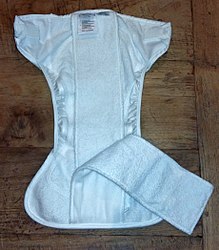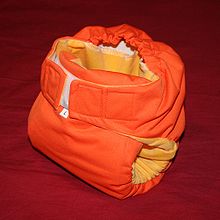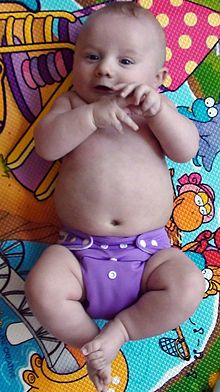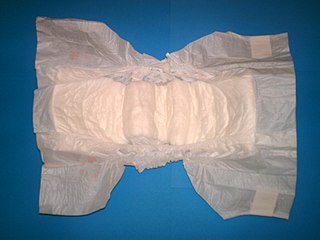
A diaper or a nappy is a type of underwear that allows the wearer to urinate or defecate without using a toilet, by absorbing or containing waste products to prevent soiling of outer clothing or the external environment. When diapers become wet or soiled, they require changing, generally by a second person such as a parent or caregiver. Failure to change a diaper on a sufficiently regular basis can result in skin problems around the area covered by the diaper.

Diaper is any of a wide range of decorative patterns used in a variety of works of art, such as stained glass, heraldic shields, architecture, and silverwork. Its chief use is in the enlivening of plain surfaces.
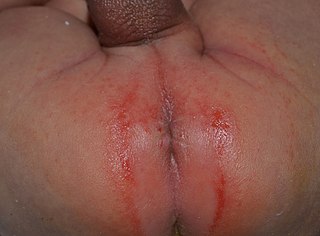
Irritant diaper dermatitis is a generic term applied to skin rash in the diaper area that are caused by various skin disorders and/or irritants.

Microfibre is synthetic fibre finer than one denier or decitex/thread, having a diameter of less than ten micrometers.

A menstrual pad, or simply a pad, is an absorbent item worn in the underwear when menstruating, bleeding after giving birth, recovering from gynecologic surgery, experiencing a miscarriage or abortion, or in any other situation where it is necessary to absorb a flow of blood from the vagina. A menstrual pad is a type of menstrual hygiene product that is worn externally, unlike tampons and menstrual cups, which are worn inside the vagina. Pads are generally changed by being stripped off the pants and panties, taking out the old pad, sticking the new one on the inside of the panties and pulling them back on. Pads are recommended to be changed every 3–4 hours to avoid certain bacteria that can fester in blood; this time also may differ depending on the kind worn, flow, and the time it is worn.

A baby sling or baby carrier is generally made of soft fabrics that wrap around the chest. They provide comfort and support for the baby and allow the parent or carer to keep their hands free as they go about their everyday tasks.

A mop is a mass or bundle of coarse strings or yarn, etc., or a piece of cloth, sponge or other absorbent material, attached to a pole or stick. It is used to soak up liquid, for cleaning floors and other surfaces, to mop up dust, or for other cleaning purposes.

A bed sheet is a rectangular piece of cloth used either singly or in a pair as bedding, which is larger in length and width than a mattress, and which is placed immediately above a mattress or bed, but below blankets and other bedding. A bottom sheet is laid above the mattress, and may be either a flat sheet or a fitted sheet. A top sheet, in the many countries where they are used, is a flat sheet, which is placed above a bottom sheet and below other bedding.

Huggies is an American company that sells disposable diapers and baby wipes that is marketed by Kimberly-Clark. Huggies were first test marketed in 1968, then introduced to the public in 1977 to replace the Kimbies brand.

Plastic pants are garments worn over a diaper to prevent liquid or solid waste from leaking through the fabric. They are waterproof with a plastic texture, rather than a soft napkin texture. Plastic pants are usually made out of polyvinyl chloride (PVC) or polyurethane (PU).
An incontinence pad is a small, impermeable multi-layered sheet with high absorbency that is used in the incontinence and health-care industries as a precaution against fecal or urinary incontinence. It is generally made of cotton if washable, or paper if disposable. Incontinence diapers are a common incontinence pad. Incontinence pads are usually placed in an undergarment or on a bed or chair under a person. Incontinence pads are manufactured in light and heavy grades which offer a range of absorbencies, often referred to as a 'working capacity', which refers to the true absorbency an incontinence pad offers when in use. These sorts of pads can come as panty-liners, inserts, pads or even available as replacement underwear.
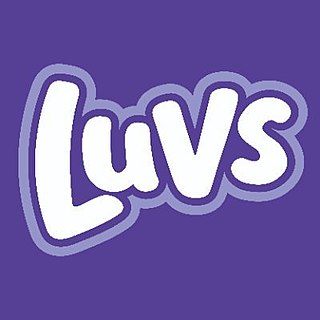
Luvs is a brand of disposable diapers made by Procter & Gamble. Luvs were sold as "Deluxe" diapers in the late 1980s. In 1994 they became budget diapers. The Luvs brand also includes baby wipes.

Cloth menstrual pads are cloth pads worn in the underwear to collect menstrual fluid. They are a type of reusable menstrual hygiene product, and are an alternative to sanitary napkins or to menstrual cups. Because they can be reused, they are generally less expensive than disposable pads over time, and reduce the amount of waste produced.
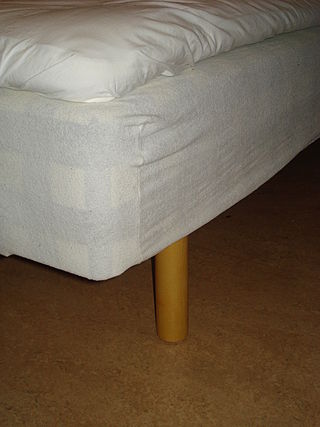
A mattress protector is an item of removable bedding that sits on top of, or encases, a mattress to protect it. Some mattress protectors also provide protection to the person sleeping on the mattress from allergens and irritants such as dust mites, bed bugs, mold, and dead skin.
gDiapers are a hybrid diaper, so users can choose to use either a cloth insert or a disposable insert that can be flushed or composted. Co-founders are Jason and Kimberley Graham-Nye. gDiapers began being sold in 2004. gDiapers are licensed from Kuver Designs Pty Ltd, Tasmania, "Eenee designs" diapers.

A swim diaper or swim nappy is a diaper that is made for those who have fecal incontinence, which is worn underneath a bathing suit, or as a bathing suit. Swim diapers can be reusable and disposable. They are not intended to be absorbent, but only to contain solid waste (feces); the lack of absorbency prevents the swim diaper from swelling with water.

Marion O'Brien Donovan was an American inventor and entrepreneur. Recognized as one of the era's most prominent female inventors, she secured a total of 20 patents for her creations. In 1946, she created a reusable, impermeable diaper cover. Ultimately, this led to the invention of the disposable paper diaper, which was eventually commercialized by Victor Mills, the creator of Pampers. Donovan also innovated various solutions around the home and was inducted into the National Inventors Hall of Fame in 2015..
Depend is a brand of absorbent, disposable underwear and undergarments for people with urinary or fecal incontinence. It is a Kimberly-Clark brand, and positions its products as an alternative to typical adult diapers. Depend is the dominant brand of disposable incontinence garments in the United States with a 49.4 share of the market.
Valerie Hunter Gordon was the British inventor of PADDI, a sustainable nappy system considered to be the world's first disposable nappy, and Nikini, an early sanitary towel system.
Ecopipo is a Mexican manufacturer of cloth diapers headquartered in Irapuato. Ixchel Anaya Meave started the business while a student in 2009 and subsequently incorporated it with her husband.




